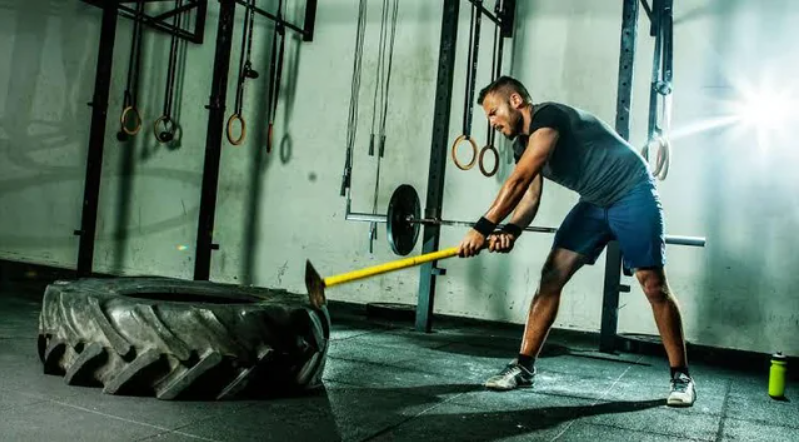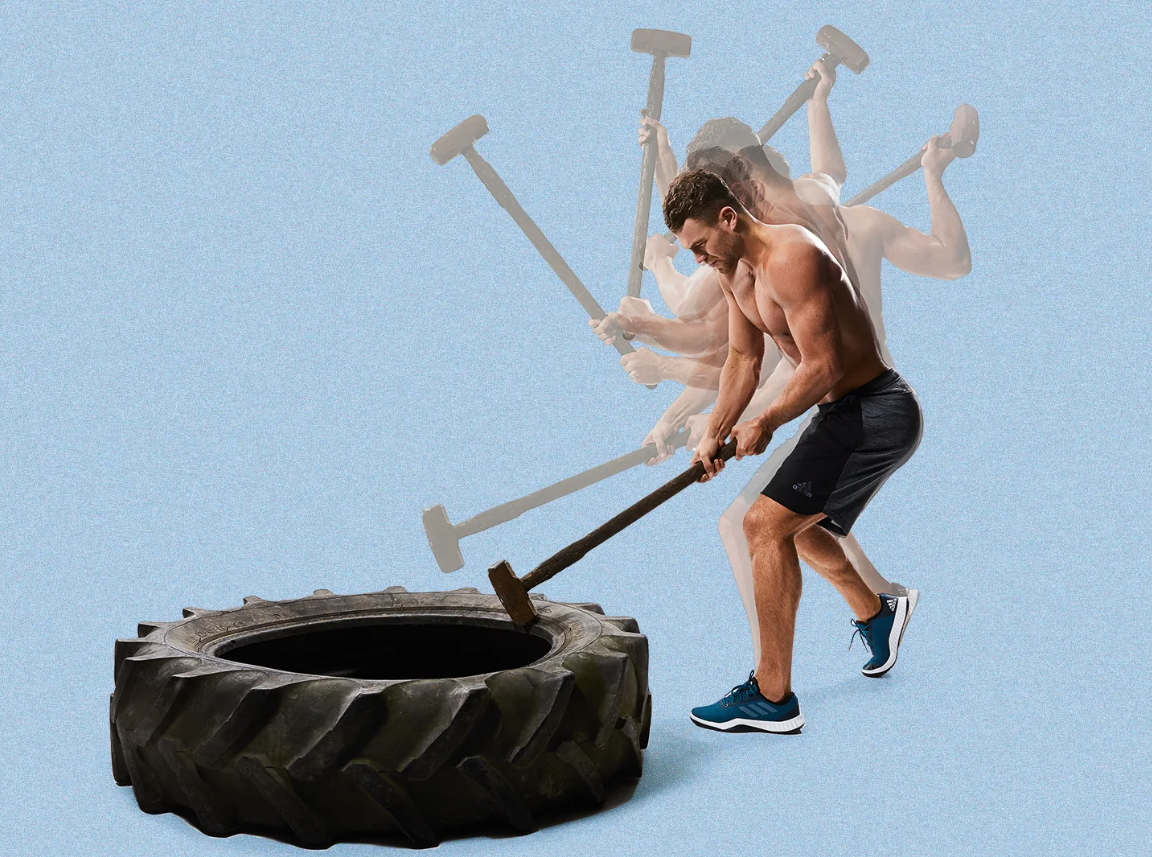In the realm of functional fitness, few exercises can match the raw power and intensity of swinging a sledgehammer. This ancient tool, once primarily used for demolition and construction, has found a new purpose in the world of strength training and conditioning. Swinging a sledgehammer is not only an exhilarating and primal experience but also a full-body workout that engages numerous muscle groups simultaneously. In this comprehensive article, we'll explore the muscles targeted when swinging a sledgehammer, the benefits of incorporating this exercise into your routine, and essential safety precautions to ensure a safe and effective workout.
Swinging a Sledgehammer

Proper Technique
Before delving into the specific muscles worked, it's crucial to understand the proper technique for swinging a sledgehammer.
- The movement involves a powerful hip hinge, followed by an explosive swing of the sledgehammer in front of the body.
- The arms should remain straight, allowing the force to transfer from the core and legs through the shoulders and into the hammer.
- Maintaining a neutral spine and engaging the core throughout the movement is essential to prevent injury and maximize the benefits.
Common Uses
Historically, sledgehammers have been used for tasks such as breaking concrete, driving stakes into the ground, and demolishing structures. However, in recent years, they have gained popularity in the fitness world as a versatile and challenging training tool. Sledgehammer workouts are commonly incorporated into high-intensity interval training (HIIT), functional fitness routines, and conditioning programs for athletes and fitness enthusiasts alike.
Benefits of Swinging a Sledgehammer Workout
Incorporating sledgehammer swings into your fitness routine offers a multitude of benefits beyond just building muscular strength and endurance. Here are some of the key advantages:
Strength Building
Swinging a heavy sledgehammer requires the recruitment of multiple muscle groups, leading to increased overall body strength. The explosive nature of the movement also helps develop power and dynamic force production.
Calorie Burn
Due to the high-intensity and full-body engagement of sledgehammer workouts, they can burn a significant number of calories in a relatively short period of time. This makes them an effective tool for weight management and overall fitness.
Cardiovascular Fitness
The intense, full-body effort required during sledgehammer swings can elevate the heart rate and challenge cardiovascular endurance, providing a effective cardio workout alongside strength training benefits.
Stress Relief and Mental Toughness
The primal act of swinging a heavy sledgehammer can be a powerful stress-relieving outlet. Additionally, the intense physical and mental demands of these workouts can cultivate mental toughness and resilience.
Which Muscles are Targeted When Swinging a Sledgehammer?
Swinging a sledgehammer is a full-body exercise that engages multiple muscle groups simultaneously. It engages Core muscles including Abs ,Lower back and Upper body muscles including shoulders ,arms and Chest muscles.Here are the primary muscles targeted during this dynamic movement:
Core Muscles
- Abs (Rectus Abdominis),The abdominal muscles play a crucial role in stabilising the core during the swinging motion, preventing excessive rotation and maintaining proper form.
- Obliques (Internal and External Obliques), The twisting and rotational forces generated during the swing engage the oblique muscles, improving core stability and rotational power.
- Lower Back (Erector Spinae), The lower back muscles are responsible for maintaining a neutral spine position and transferring force from the legs to the upper body during the swing.
Upper Body Muscles
- Shoulders (Deltoids), The shoulder muscles, particularly the anterior and posterior deltoids, are heavily involved in the explosive swinging motion, generating power and stability.
- Biceps (Biceps Brachii), While the biceps are not the primary movers during the swing, they assist in stabilising the arms and maintaining grip strength.
- Triceps (Triceps Brachii), The triceps play a role in the follow-through phase of the swing, helping to decelerate the hammer and control the movement.
- Chest (Pectoralis Major and Minor), The chest muscles are engaged during the swing to stabilise the shoulder girdle and transfer force from the core to the arms.
What are the safety precautions while using a sledgehammer?
While swinging a sledgehammer can be an incredibly rewarding and challenging workout, it's essential to prioritise safety to prevent injuries. Here are some crucial precautions and safety measures to consider:
Warm-Up Exercises
Before attempting any sledgehammer swings, it's crucial to warm up properly. This can include dynamic stretches, light cardio, and mobility exercises to prepare the muscles and joints for the intense movements ahead.
Proper Gear
Investing in the right gear can help ensure a safe and comfortable workout. This may include:
- Sledgehammer with a secure and comfortable grip
- Sturdy shoes with good traction
- Gloves to protect the hands and improve grip
- Eye protection to prevent debris from entering the eyes
Injury Prevention Tips
- Start with a lighter sledgehammer and gradually increase the weight as you build strength and confidence.
- Maintain proper form throughout the exercise, focusing on engaging the core and using the legs to generate power.
- Listen to your body and stop immediately if you experience pain or discomfort.
- Ensure adequate rest and recovery between sets and workout sessions.
Alternative Exercises to Target Similar Muscles
While sledgehammer swings offer a unique and comprehensive full-body workout, there are alternative exercises that can target similar muscle groups. These exercises can be incorporated as part of a well-rounded fitness routine or used as a substitute when access to a sledgehammer is limited:
Kettlebell Swings
Kettlebell swings are a popular alternative to sledgehammer swings, as they engage many of the same muscle groups, including the core, shoulders, and posterior chain. They can be performed with varying weights and can be easily incorporated into HIIT or strength training sessions.
Medicine Ball Slams
Medicine ball slams mimic the explosive and powerful motion of sledgehammer swings, challenging the core, shoulders, and overall body stability. This exercise can be performed with different weight medicine balls and against a sturdy surface, such as a wall or floor.
Sample Sledgehammer Workout Routine
To help you incorporate sledgehammer swings into your fitness routine, here's a sample workout that targets multiple muscle groups while providing a challenging and dynamic full-body experience:
Warm-Up
- Dynamic stretches (e.g., arm circles, leg swings, hip rotations)
- Light cardio (e.g., jumping jacks, high knees, butt kicks)
- Mobility exercises (e.g., shoulder rotations, hip openers)
Workout
- Sledgehammer Swings: 4 sets of 15-20 reps
- Focus on engaging the core and using the legs to generate power.
- Maintain a neutral spine and avoid excessive twisting or leaning.
- Push-Ups: 3 sets of 10-15 reps
- Engage the core and keep the body in a straight line.
- Modify by performing pushups on your knees or against a wall if needed.
- Squats: 3 sets of 15-20 reps
- Keep the chest upright and engage the core throughout the movement.
- Ensure proper depth by sending the hips back and down.
- Plank: 2 sets of 45-60 seconds
- Maintain a straight line from head to heels, engaging the core muscles.
- Modify by performing the plank on your forearms if needed.
- Sledgehammer Slams: 3 sets of 10-15 reps
- Raise the sledgehammer overhead and forcefully slam it down into the ground.
- Engage the core and use the legs to generate power.
Progression Tips
- Increase the weight of the sledgehammer gradually as you build strength and confidence.
- Add additional exercises to target specific muscle groups or increase the overall intensity.
- Adjust the number of sets, reps, and rest periods based on your fitness level and goals.
Remember, proper form and safety should always be prioritised when engaging in sledgehammer workouts or any other high-intensity exercise routine. It's also essential to listen to your body and adjust the intensity or take breaks as needed to prevent injury and ensure a sustainable and enjoyable fitness journey.
Conclusion
In conclusion, swinging a sledgehammer is a full-body workout that engages a wide range of muscles, including the core, shoulders, arms, and lower body. By incorporating this dynamic and explosive exercise into your routine, you can build strength, improve cardiovascular fitness, and challenge your body in new and exciting ways. However, it's crucial to prioritise proper technique, safety precautions, and a well-rounded approach to achieve optimal results and prevent injuries.










